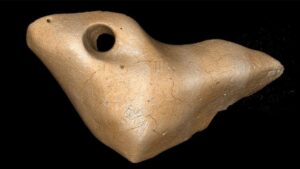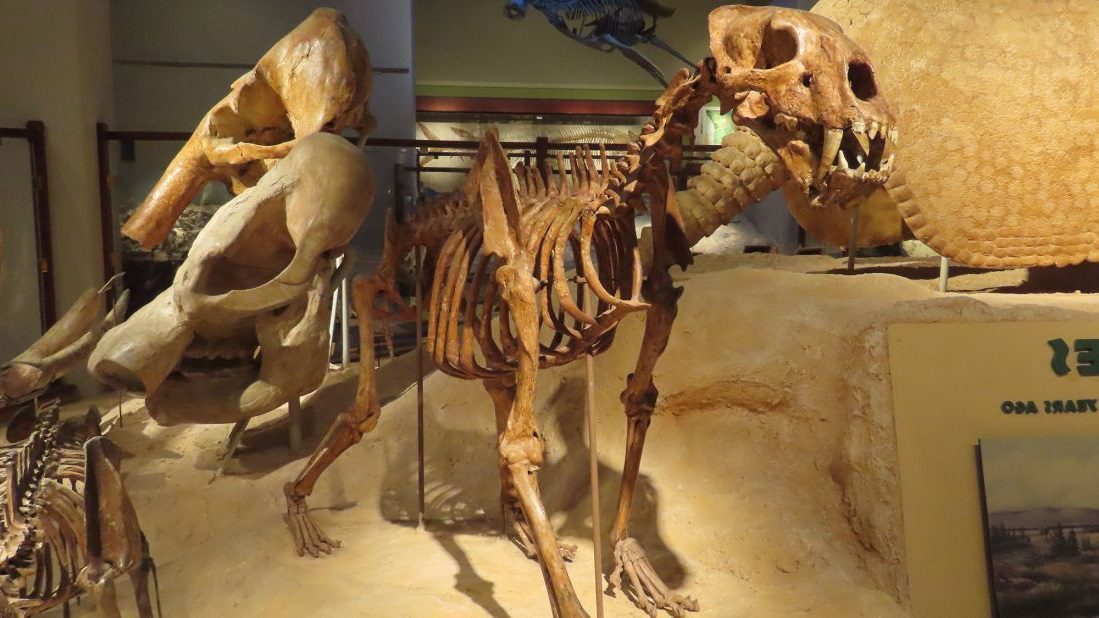Revolutionary Discovery: Three giant sloth bones were found in Brazil by archaeologists, challenging our understanding of the first Americans. At the Santa Elina rock shelter, these ancient bones show signs of human manipulation, suggesting they were used as pendants. These personal ornaments, estimated to be between 25,000 and 27,000 years old, are the oldest in the Americas and the only ones made from giant sloth bones.
Astonishing Artefacts
The rock shelter’s osteoderms included three sloth-bone pendants, according to Brazilian palaeontologist Thais Pansani. Sloths have armadillo-like osteoderms on their skin. Extinct giant sloth Glossotherium phoenesis had these osteoderms. Scientists have trouble dating the site’s rock art, which depicts animals and humans.
Giant Sloth Size
Glossotherium phoenesis weighed 600 kilogrammes (1,323 pounds), larger than most brown bears. This giant sloth was small, but some ancient sloth species were so large that their fossilised burrows have become walkable caves in southern Brazil.
Analysis and Experiments
The polishing and hole placement give the artefacts their unique pendant shape, according to Mírian Pacheco, a professor and researcher at the Laboratory of Paleobiology and Astrobiology at the Federal University of São Carlos. The researchers examined modified and unmodified osteoderms from fossilised bones and modern armadillo osteoderms, the closest analogue, to understand how these pendants were made. Microscopic marks on the bones indicate human polishing before fossilisation.
Human-Giant Sloth Coexistence
Pacheco believes humans and giant sloths shared Santa Elina. Herbivores with digging claws, giant sloths were harmless to humans. These low-metabolism animals moved on all fours but could stand up to reach food in trees. It is unclear whether humans saw these creatures as threats or as part of their environment.
Estimating Artefact Age
To protect the rare pendants, direct dating was not done. Sediment, charcoal, and more giant sloth bones were dated in the same layer. These dates indicate that the pendants are 27,00025,000 years old.
Tracing Human Occupation
Archaeologists debate whether modern humans colonised North and South America. Recent evidence suggests that early humans reached South America before 16,000 years ago, contrary to the beliefs of many experts. New Mexico’s 21,00023,000-year-old fossilised human footprints have shaped this debate.

READ MORE: Huw Edwards: BBC Anchor Faces Allegations, Wife Reveals”
Historic Human Occupations
Pacheco’s hypothesis of older American human occupations is supported by the Santa Elina artefacts’ age. Recent advances in noninvasively extracting ancient DNA from bone artefacts offer promising future research. This innovative technique has already revealed fascinating details from a pierced deer tooth found in a Russian cave, likely used as a pendant.
Research and Future Opportunities
Pacheco says the team is investigating whether fossilisation and weathering caused sloth-bone pendant substitutions. Extraction of genetic material from well-preserved artefacts may be possible.
Conclusion Of Revolutionary Discovery
Recent Proceedings of the Royal Society B findings shed light on early human presence in the Americas. This discovery shows our ancestors’ complex relationship with the continent’s fascinating megafauna. We learn more about human migration and cultural evolution with each new discovery. The Santa Elina artefacts show early humans’ ingenuity and creativity, revealing their lives and complex interactions with their environment.
Our Reader’s Queries
What is the greatest discovery of all time?
RNA-sequencing, penicillin, DNA molecular structure, electricity, levodopa, painkillers, anaesthetic, vaccines, and our teamwork ability stand out as some of the greatest scientific discoveries of all time. While we often celebrate the prominent scientists and their groundbreaking discoveries, it’s important to remember that science is a collective effort that impacts all of us. It should be accessible and shared by everyone.
What was the most important discovery of the Scientific Revolution?
Astronomy’s scientific revolution brought about Copernicus’s Heliocentric model and Galileo Galilei’s telescope. Math developed calculus, probability, and analytical geometry. Biology advanced with the science of human anatomy.
What is an example of revolutionary science?
Discoveries like the heliocentric theory, Newtonian physics, germ theory of disease, quantum theory, plate tectonics, and the finding that DNA holds genetic information are just a few examples.
What is the latest discovery of science in 2023?
Seven groundbreaking scientific findings of 2023 that may spark innovation: Asp caterpillar venom punctures cell walls, hibernating bears are resistant to blood clots, certain crustaceans have reflective eyes for camouflage, and monarch butterflies utilize spots on their wings for increased lift.

